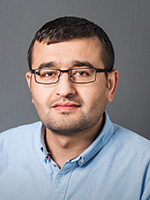Where are they now? Aziz Khan: from postdoc at NCMM to Staff Scientist
The “Where Are They Now? Nordic EMBL Partnership Alumni Careers” profile series introduces readers to alumni of the Nordic EMBL Partnership and the careers that they have embarked on. This month we meet Aziz Khan a former postdoc at NCMM and his new career as a staff scientist.

Note: This article originally appeared on the NCMM website: https://www.med.uio.no/ncmm/english/people/alumni/group-leaders/ncmm-alumni-aziz-khan.html
In 2016 Dr Aziz Khan joined the Mathelier group to continue his research in regulatory genomics and epigenomics. He is now a staff scientist at the Curtis Lab at the Stanford Cancer Institute.
How did you come to do your postdoc with the Mathelier group?
It is quite an interesting story. But in short, through Twitter. It was June 2016. My PhD thesis was in, the public dissertation defense was scheduled - I started looking for postdoc opportunities in the US. At the same time, I was working on my application and checking potential labs. The newly elected administration in the US started making nonimmigrant visas more challenging while banning certain countries from entering. That made me drop my American dream and turn towards Europe.
During that time, I joined the Academic Twitter and started following members of the gene regulation community. And Anthony was among those. Anthony was tweeting about his brand new independent lab at NCMM. He was hiring a postdoc and tweeted about it. I showed my interest by replying to his tweet, but late, the application deadline was already passed. Well, he managed to extend the deadline for application submission. My application was in; fast forward, I was interviewed and got an offer.
Until then, I did not know much about research in Norway. Of course, I learned about Norway through the Norwegian Nobel Peace Prize and oil. I started reading more about the research culture in Norway, NCMM, and the University of Oslo. Of course, I came across the list of happiest nations in the world, with Norway on the top. I said yes to the offer, to trade everything for happiness. No, seriously, my research interests in regulatory genomics and epigenomics were well aligned with the aims of the Mathelier group.
I got the visa without any trouble and hassle. I was in Norway within a month to start my postdoc journey.
What did you most enjoy about your time as a postdoc?
For sure, not the winter. I have enjoyed several things during my three years’ stay at NCMM. I have enjoyed and cherished academic freedom and safety. I thank Anthony for trusting in me and allowing me to explore my scientific curiosity and practice academic activism. I enjoyed and learned while collaborating with colleagues in the Mathelier group and also inside and outside NCMM. During the postdoc, I got involved with several initiatives led by early-career researchers to advocate for best practices in science and develop resources. Last but not least, I did learn a very Norwegian thing, cross country skiing, and I loved it.
How did your time at NCMM help to shape your career path?
No doubt, my stay at NCMM has been very transformative in shaping my career path. Being the first postdoc in the lab allowed me to see and learn things firsthand while the Mathelier lab was growing and research evolving.
It provided opportunities to engage with the local and international bioinformatics and gene regulation community. I had the privilege to participate in several international conferences to network and present our work through talks and poster presentations. That helped to enhance my research and commutation skills and also broaden my academic network.
During these three years, Anthony, his team, and I accomplished great things together, and I am very proud of it.
Can you tell us about your new role at Stanford, and what you are working on now?
As a staff scientist in Curtis Lab at the Stanford Cancer Institute, my primary role is to work with other lab members and collaborators and support research projects. I oversee the development and adoption of reproducible pipelines and methods for genomic and epigenomic data analysis, both at bulk and single-cell resolution and organoid models.
I am also part of the Human Tumor Atlas Network (HTAN), which is a National Cancer Institute (NCI) funded project under the Cancer Moonshot initiative. HTAN aims to create dynamic 3D maps of human tumors to advance cancer research. It is a collaborative consortium constructing 3-dimensional atlases of the cellular, morphological, and molecular features of human cancers over time. At Stanford, we are part of the joint forces to establish state-of-the-art pre-cancer atlases for colorectal cancer (CRC) using Familial Adenomatous Polyposis (FAP) and breast cancer by using the multi-scale information on ductal carcinoma in situ (DCIS), a preinvasive breast cancer precursor.
Apart from research, I continue my advocacy for open science, open-source, preprints, and reproducibility in research. I often tweet about these research practices from @khanaziz84
Do you still collaborate with anyone from the Mathelier group/UiO?
Yes, I do collaborate. We just completed and published two projects after I started at Stanford. Of course, the JASPAR database has been very close to my heart. I co-led the 2018 and 2020 releases of JASPAR. Alongside the Mathelier group and other JASPAR collaborators, we completed and submitted the paper associated with the updated 9th release of the database, JASPAR2022. The resources we build together do need long-term collaboration to keep those well maintained and running. I am sure there will be more opportunities in the future to collaborate with the Mathelier group.